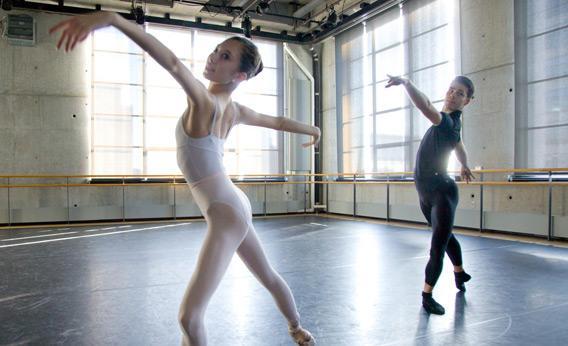There may be no other art form that’s as fascinating to see being made as dance. All those physical feats that look so effortless onstage—the weightless jumps and mathematically precise pirouettes—are, of course, the result of years of almost superhuman effort backstage, and watching a routine in the process of being put together makes the airy simplicity of the final product seem all the more miraculous. First Position, the debut film of former ballerina Bess Kargman, is both a process documentary about ballet and a straight-up sports movie. It follows six young dancers as they prepare for and compete in the Youth America Grand Prix, an international competition that awards scholarships and positions in dance companies to students from ages 9 to 19.
As a Grand Prix official points out near the beginning of the film, aspiring dancers are under great pressure in their late teens to position themselves for a job—careers in ballet don’t last long, so they need to get started as young as possible, and the competition for spots in professional companies is unimaginably intense: Out of 5,000 entrants in the competition, only 300 will make it to the finals. Kargman’s six subjects, who range in age from 11 to 17, all come across as serious and mature beyond their years (even if the movie does open with one of them enjoying a thoroughly kidlike bounce on a pogo stick). The mother of Gaya, an 11-year-old Israeli girl with a strikingly angular, modern style, explains how, when her daughter begins to dance, “I see the age is changing, the concentration is changing—she becomes an adult when she dances.”
Gaya’s best friend Aran, the son of a Navy doctor stationed in Italy, travels two hours every day to Marseille to study with a French dance coach. Joan Sebastian, an astonishingly gifted 16-year-old from a working-class family in Colombia, has come to New York on his own to study; in their daily phone calls, his parents reminds him how many people back home are depending on his success. A preteen brother-and-sister pair from California, Jules and Miko Fogarty, are driven still harder by their anxious, aspirational mother, who annoys the children’s dance teacher with her unsolicited posture tips and weeps when she finally realizes what viewers can see right from the start: that her son lacks both the talent and the passion to pursue ballet with the tenacity of his older sister. There aren’t any parents here at a Black Swan level of stage-mother dysfunction, but as Miko’s mother serves her already gaunt daughter broccoli and nonfat yogurt, you can’t help but worry about the eating disorders that plague the dance world (happily, the other kids are shown chowing down on ice cream, guacamole, and chicken stew).
Rebecca, a high-school senior from Maryland who’s earned the nickname “Barbie” for her long blond hair, princessy demeanor, and impossibly bendable body, has decided to try for a spot in a company rather than attend college; after investing in her training for more than a decade, her parents can only hope the decision pays off. (A well-made tutu, we’re told, costs between $1,500 and $2,500; a pair of pointe shoes can cost $80 and sometimes last no longer than a single wearing.)
The most moving story belongs to Michaela, a 14-year-old adopted as a small child from war-torn Sierra Leone, who lost both her parents and remembers seeing a teacher hacked to pieces before her eyes. Languishing in an orphanage, where she had trouble finding an adoptive family because of the vitiligo that mottled her neck and chest, she became fixated on the cover of a dance magazine that showed a woman on point in a pink tutu. “That was the only thing I lived for, was to become this person, to be exactly like this ballerina,” she tells the camera, going on to describe the stereotypes surrounding black women in ballet: “You’re too muscular, you’re not graceful enough. … I want to be known as a delicate black dancer who does classical ballet.” With the support of the loving Philadelphia family who eventually adopted her, Michaela has come close to achieving that dream–but her insistence on competing in the Grand Prix finals despite a severe Achilles tendon injury runs the risk of ending her career for good.
First Position is a kind of dance-world version of Spellbound, the wonderful 2003 documentary that followed eight participants through the process of preparing for the Scripps National Spelling Bee. Over the movie’s 90-minute running time you get to know and root for all six of these very different kids, and to alternately sympathize with and roll your eyes at their endlessly self-sacrificing, occasionally overinvolved parents. As the action moves from the first round of Grand Prix competition in Sicily to the finals in New York, the suspense ratchets up steadily: You can’t bear the idea of seeing any one of the children’s faces fall as the names of the winners are called out.
First Position is an unabashedly inspirational portrait of what even very young people can accomplish with discipline and dedication (though the original score lays it on a little thick sometimes with the soaring musical cues). Kargman offers glimpses of behind-the-scenes ballet-world details that even season-ticket holders rarely get to see: a seamstress putting in the 100 hours it takes to sew a tutu, or a torturous-looking wooden device used for strengthening the arch of the foot. I watched First Position with my 6-year-old daughter, a budding dancer herself, and when it was over, she launched into a spontaneous re-creation of Gaya’s loose-jointed “cartoon girl” dance, which was created by Gaya’s mother, a well-known Israeli choreographer. My girl may not yet fully grasp how much work it takes to achieve these children’s level of artistry, but she instinctively understood another key theme of this irresistible documentary: If you love what you do enough, great things are possible.
